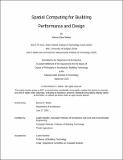Spatial Computing for Building Performance and Design
Author(s)
Weber, Ramon Elias
DownloadThesis PDF (7.566Mb)
Advisor
Mueller, Caitlin
Reinhart, Christoph
Terms of use
Metadata
Show full item recordAbstract
Accommodating urban population growth while reducing emissions from the built environment poses an unprecedented challenge to the architectural discipline. To enable more sustainable construction, the dissertation proposes a new computational design framework to investigate how building performance from an environmental and user perspective relates to spatial design. The dissertation surveys existing computational methodologies for design automation and identifies new opportunities and value propositions for architectural computing in design guidance, feedback, and optimization. Exploring methods that can be used to generate and optimize structural systems of buildings and interior layouts, a specific focus lies in the design of residential buildings. By applying generative design methods to building analytics, new ways for estimating the embodied carbon of a building and the environmental impact of system-level design choices can be explored.
First, the research demonstrates how generative geometric algorithms can be coupled with structural simulations to accurately predict the structural material quantity and, through that, the embodied carbon of a building in early stages of design. Second, a new method for representing, analyzing, and generating spatial layouts – the hypergraph – is proposed, that captures the characteristics of any given floor plan. Unveiling new architectural opportunities through automatic geometry creation, the hypergraph shows potential to improve the quality of residential spaces in terms of environmental performance and access to daylight. Enabling new design tools for architects, it offers creative applications and new collaborative workflows for incorporating new spatial metrics in the design process. Allowing for new quantitative insights in building performance, the research demonstrates that spatial efficiency can outperform envelope upgrades in terms of carbon emission savings.
Date issued
2024-09Department
Massachusetts Institute of Technology. Department of ArchitecturePublisher
Massachusetts Institute of Technology